- 15.8 Bootstrap 弹出框(Popover)插件_弹出框插件
- 2Python 使用和高性能技巧总结_python高性能编程心得
- 3UE4 HTTP 请求插件说明(DTHttpRequest)_ue4http头添加修改的方式
- 4【从零开始学习Redis | 第七篇】利用Redis构造全局唯一ID(含其他构造方法)
- 5Unity编辑器下打开沙盒路径_unity 编辑器下 读取沙盒
- 6Unity创建 .asset配置文件的方式_unity c# asset 配置
- 7c#学习笔记(一)c#注册与登录界面_c# 注册登录远吗
- 8Unity物体上有碰撞体组件但是不响应鼠标点击事件_unity物体的点击碰撞体被其他碰撞体覆盖
- 9加密芯片ATSHA204之使用
- 10Linux系统虚拟机中挂载及使用光盘_linux虚拟机挂盘安装软件包并摘盘
建议收藏,22个Python迷你项目(附源码)_python做的简单项目
赞
踩
在使用Python的过程中,我最喜欢的就是Python的各种第三方库,能够完成很多操作。
下面就给大家介绍22个通过Python构建的项目,以此来学习Python编程。
大家也可根据项目的目的及提示,自己构建解决方法,提高编程水平。
① 骰子模拟器
目的:创建一个程序来模拟掷骰子。
提示:当用户询问时,使用random模块生成一个1到6之间的数字。

② 石头剪刀布游戏
目标:创建一个命令行游戏,游戏者可以在石头、剪刀和布之间进行选择,与计算机PK。如果游戏者赢了,得分就会添加,直到结束游戏时,最终的分数会展示给游戏者。
提示:接收游戏者的选择,并且与计算机的选择进行比较。计算机的选择是从选择列表中随机选取的。如果游戏者获胜,则增加1分。
import random choices = ["Rock", "Paper", "Scissors"] computer = random.choice(choices) player = False cpu_score = 0 player_score = 0 while True: player = input("Rock, Paper or Scissors?").capitalize() # 判断游戏者和电脑的选择 if player == computer: print("Tie!") elif player == "Rock": if computer == "Paper": print("You lose!", computer, "covers", player) cpu_score+=1 else: print("You win!", player, "smashes", computer) player_score+=1 elif player == "Paper": if computer == "Scissors": print("You lose!", computer, "cut", player) cpu_score+=1 else: print("You win!", player, "covers", computer) player_score+=1 elif player == "Scissors": if computer == "Rock": print("You lose...", computer, "smashes", player) cpu_score+=1 else: print("You win!", player, "cut", computer) player_score+=1 elif player=='E': print("Final Scores:") print(f"CPU:{cpu_score}") print(f"Plaer:{player_score}") break else: print("That's not a valid play. Check your spelling!") computer = random.choice(choices)
- 1
- 2
- 3
- 4
- 5
- 6
- 7
- 8
- 9
- 10
- 11
- 12
- 13
- 14
- 15
- 16
- 17
- 18
- 19
- 20
- 21
- 22
- 23
- 24
- 25
- 26
- 27
- 28
- 29
- 30
- 31
- 32
- 33
- 34
- 35
- 36
- 37
- 38
- 39
- 40
③ 随机密码生成器
目标:创建一个程序,可指定密码长度,生成一串随机密码。
提示:创建一个数字+大写字母+小写字母+特殊字符的字符串。根据设定的密码长度随机生成一串密码。

④ 句子生成器

目的:通过用户提供的输入,来生成随机且唯一的句子。
提示:以用户输入的名词、代词、形容词等作为输入,然后将所有数据添加到句子中,并将其组合返回。
⑤ 猜数字游戏
目的:在这个游戏中,任务是创建一个脚本,能够在一个范围内生成一个随机数。如果用户在三次机会中猜对了数字,那么用户赢得游戏,否则用户输。
提示:生成一个随机数,然后使用循环给用户三次猜测机会,根据用户的猜测打印最终的结果。
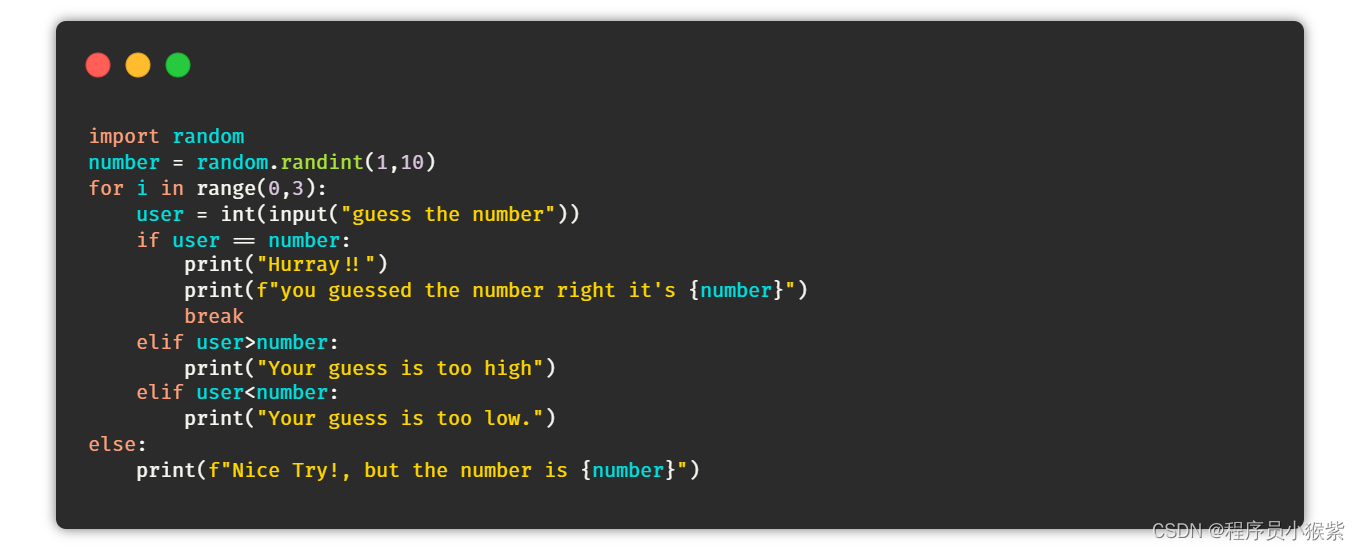
⑥ 故事生成器
目的:每次用户运行程序时,都会生成一个随机的故事。
提示:random模块可以用来选择故事的随机部分,内容来自每个列表里。
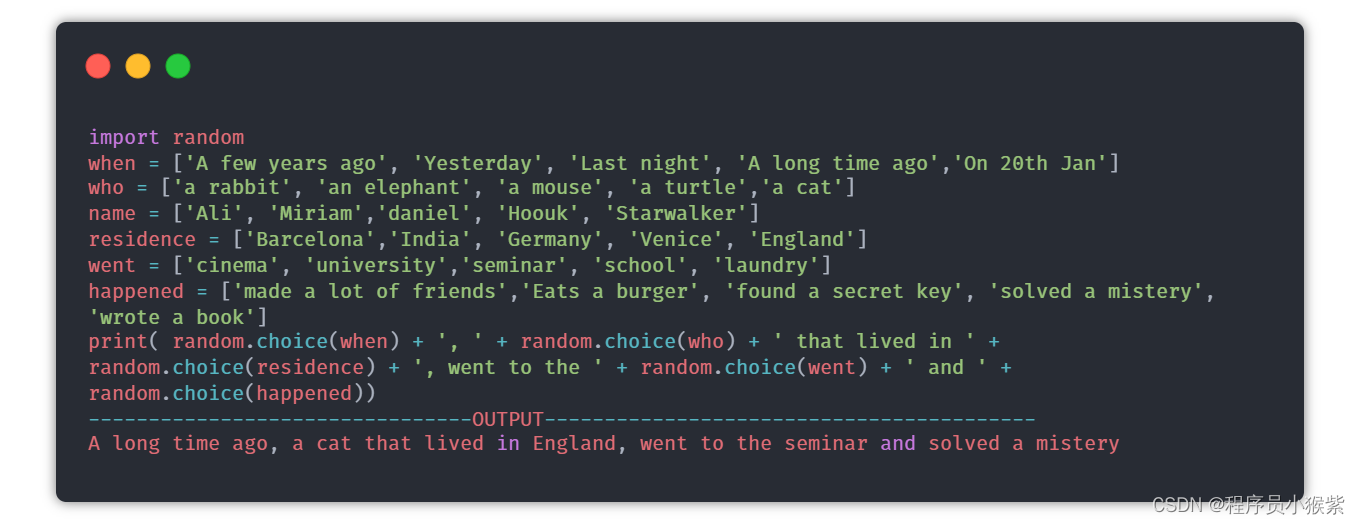
⑦ 邮件地址切片器
目的:编写一个Python脚本,可以从邮件地址中获取用户名和域名。
提示:使用@作为分隔符,将地址分为分为两个字符串。
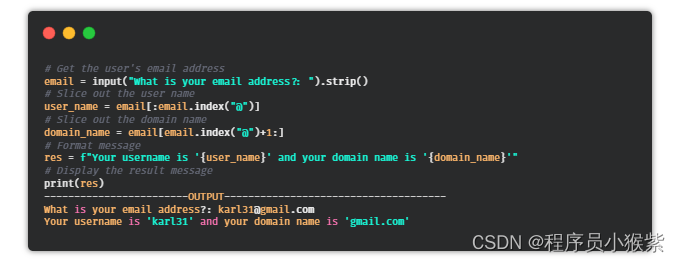
⑧ 自动发送邮件
目的:编写一个Python脚本,可以使用这个脚本发送电子邮件。
提示:email库可用于发送电子邮件。
import smtplib
from email.message import EmailMessage
email = EmailMessage() ## Creating a object for EmailMessage
email['from'] = 'xyz name' ## Person who is sending
email['to'] = 'xyz id' ## Whom we are sending
email['subject'] = 'xyz subject' ## Subject of email
email.set_content("Xyz content of email") ## content of email
with smtlib.SMTP(host='smtp.gmail.com',port=587)as smtp:
## sending request to server
smtp.ehlo() ## server object
smtp.starttls() ## used to send data between server and client
smtp.login("email_id","Password") ## login id and password of gmail
smtp.send_message(email) ## Sending email
print("email send") ## Printing success message
- 1
- 2
- 3
- 4
- 5
- 6
- 7
- 8
- 9
- 10
- 11
- 12
- 13
- 14
⑨ 缩写词
目的:编写一个Python脚本,从给定的句子生成一个缩写词。
提示:你可以通过拆分和索引来获取第一个单词,然后将其组合。
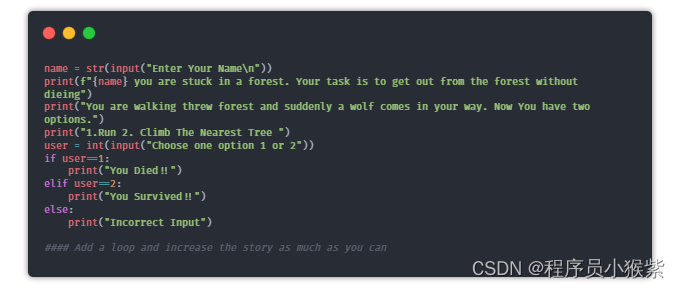
⑩ 文字冒险游戏
目的:编写一个有趣的Python脚本,通过为路径选择不同的选项让用户进行有趣的冒险。

在学习python中有任何困难不懂的可以微信扫描下方CSDN官方认证二维码
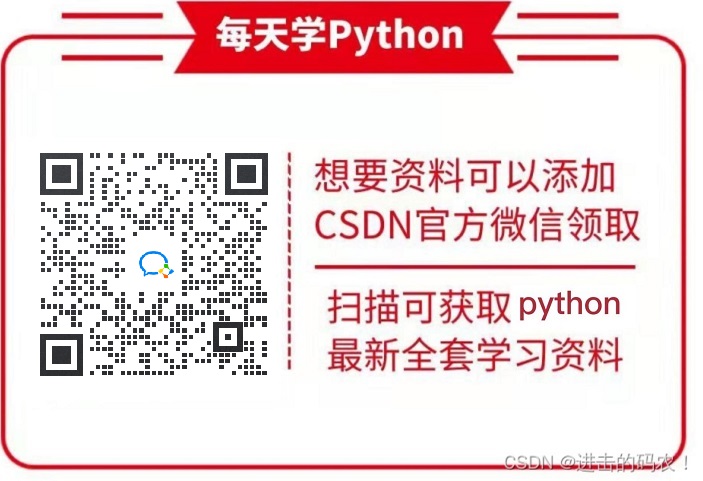
⑪ Hangman
目的:创建一个简单的命令行hangman游戏。
提示:创建一个密码词的列表并随机选择一个单词。现在将每个单词用下划线“”表示,给用户提供猜单词的机会,如果用户猜对了单词,则将“”用单词替换。
import time import random name = input("What is your name? ") print ("Hello, " + name, "Time to play hangman!") time.sleep(1) print ("Start guessing...\n") time.sleep(0.5) ## A List Of Secret Words words = ['python','programming','treasure','creative','medium','horror'] word = random.choice(words) guesses = '' turns = 5 while turns > 0: failed = 0 for char in word: if char in guesses: print (char,end="") else: print ("_",end=""), failed += 1 if failed == 0: print ("\nYou won") break guess = input("\nguess a character:") guesses += guess if guess not in word: turns -= 1 print("\nWrong") print("\nYou have", + turns, 'more guesses') if turns == 0: print ("\nYou Lose")
- 1
- 2
- 3
- 4
- 5
- 6
- 7
- 8
- 9
- 10
- 11
- 12
- 13
- 14
- 15
- 16
- 17
- 18
- 19
- 20
- 21
⑫ 闹钟
目的:编写一个创建闹钟的Python脚本。
提示:你可以使用date-time模块创建闹钟,以及playsound库播放声音。
from datetime import datetime from playsound import playsound alarm_time = input("Enter the time of alarm to be set:HH:MM:SS\n") alarm_hour=alarm_time[0:2] alarm_minute=alarm_time[3:5] alarm_seconds=alarm_time[6:8] alarm_period = alarm_time[9:11].upper() print("Setting up alarm..") while True: now = datetime.now() current_hour = now.strftime("%I") current_minute = now.strftime("%M") current_seconds = now.strftime("%S") current_period = now.strftime("%p") if(alarm_period==current_period): if(alarm_hour==current_hour): if(alarm_minute==current_minute): if(alarm_seconds==current_seconds): print("Wake Up!") playsound('audio.mp3') ## download the alarm sound from link break
- 1
- 2
- 3
- 4
- 5
- 6
- 7
- 8
- 9
- 10
- 11
- 12
- 13
- 14
- 15
- 16
- 17
- 18
- 19
- 20
- 21
⑬ 有声读物
目的:编写一个Python脚本,用于将Pdf文件转换为有声读物。
提示:借助pyttsx3库将文本转换为语音。
安装:pyttsx3,PyPDF2

⑭ 天气应用
目的:编写一个Python脚本,接收城市名称并使用爬虫获取该城市的天气信息。
提示:你可以使用Beautifulsoup和requests库直接从谷歌主页爬取数据。
安装:requests,BeautifulSoup
from bs4 import BeautifulSoup import requests headers = {'User-Agent': 'Mozilla/5.0 (Windows NT 10.0; Win64; x64) AppleWebKit/537.36 (KHTML, like Gecko) Chrome/58.0.3029.110 Safari/537.3'} def weather(city): city=city.replace(" ","+") res = requests.get(f'https://www.google.com/search?q={city}&oq={city}&aqs=chrome.0.35i39l2j0l4j46j69i60.6128j1j7&sourceid=chrome&ie=UTF-8',headers=headers) print("Searching in google......\n") soup = BeautifulSoup(res.text,'html.parser') location = soup.select('#wob_loc')[0].getText().strip() time = soup.select('#wob_dts')[0].getText().strip() info = soup.select('#wob_dc')[0].getText().strip() weather = soup.select('#wob_tm')[0].getText().strip() print(location) print(time) print(info) print(weather+"°C") print("enter the city name") city=input() city=city+" weather" weather(city)
- 1
- 2
- 3
- 4
- 5
- 6
- 7
- 8
- 9
- 10
- 11
- 12
- 13
- 14
- 15
- 16
- 17
- 18
- 19
- 20
- 21
- 22
⑮ 人脸检测
目的:编写一个Python脚本,可以检测图像中的人脸,并将所有的人脸保存在一个文件夹中。
提示:可以使用haar级联分类器对人脸进行检测。它返回的人脸坐标信息,可以保存在一个文件中。
安装:OpenCV。
下载:haarcascade_frontalface_default.xml
import cv2 # Load the cascade face_cascade = cv2.CascadeClassifier('haarcascade_frontalface_default.xml') # Read the input image img = cv2.imread('images/img0.jpg') # Convert into grayscale gray = cv2.cvtColor(img, cv2.COLOR_BGR2GRAY) # Detect faces faces = face_cascade.detectMultiScale(gray, 1.3, 4) # Draw rectangle around the faces for (x, y, w, h) in faces: cv2.rectangle(img, (x, y), (x+w, y+h), (255, 0, 0), 2) crop_face = img[y:y + h, x:x + w] cv2.imwrite(str(w) + str(h) + '_faces.jpg', crop_face) # Display the output cv2.imshow('img', img) cv2.imshow("imgcropped",crop_face) cv2.waitKey()
- 1
- 2
- 3
- 4
- 5
- 6
- 7
- 8
- 9
- 10
- 11
- 12
- 13
- 14
- 15
- 16
- 17
- 18
⑯ 提醒应用
目的:创建一个提醒应用程序,在特定的时间提醒你做一些事情(桌面通知)。
提示:Time模块可以用来跟踪提醒时间,toastnotifier库可以用来显示桌面通知。
安装:win10toast
from win10toast import ToastNotifier import time toaster = ToastNotifier() try: print("Title of reminder") header = input() print("Message of reminder") text = input() print("In how many minutes?") time_min = input() time_min=float(time_min) except: header = input("Title of reminder\n") text = input("Message of remindar\n") time_min=float(input("In how many minutes?\n")) time_min = time_min * 60 print("Setting up reminder..") time.sleep(2) print("all set!") time.sleep(time_min) toaster.show_toast(f"{header}", f"{text}", duration=10, threaded=True) while toaster.notification_active(): time.sleep(0.005)
- 1
- 2
- 3
- 4
- 5
- 6
- 7
- 8
- 9
- 10
- 11
- 12
- 13
- 14
- 15
- 16
- 17
- 18
- 19
- 20
- 21
- 22
- 23
- 24
- 25
⑰ 维基百科文章摘要
目的:使用一种简单的方法从用户提供的文章链接中生成摘要。
提示:你可以使用爬虫获取文章数据,通过提取生成摘要。
from bs4 import BeautifulSoup import re import requests import heapq from nltk.tokenize import sent_tokenize,word_tokenize from nltk.corpus import stopwords url = str(input("Paste the url"\n")) num = int(input("Enter the Number of Sentence you want in the summary")) num = int(num) headers = {'User-Agent': 'Mozilla/5.0 (Windows NT 10.0; Win64; x64) AppleWebKit/537.36 (KHTML, like Gecko) Chrome/58.0.3029.110 Safari/537.3'} #url = str(input("Paste the url.......")) res = requests.get(url,headers=headers) summary = "" soup = BeautifulSoup(res.text,'html.parser') content = soup.findAll("p") for text in content: summary +=text.text def clean(text): text = re.sub(r"\[[0-9]*\]"," ",text) text = text.lower() text = re.sub(r'\s+'," ",text) text = re.sub(r","," ",text) return text summary = clean(summary) print("Getting the data......\n") ##Tokenixing sent_tokens = sent_tokenize(summary) summary = re.sub(r"[^a-zA-z]"," ",summary) word_tokens = word_tokenize(summary) ## Removing Stop words word_frequency = {} stopwords = set(stopwords.words("english")) for word in word_tokens: if word not in stopwords: if word not in word_frequency.keys(): word_frequency[word]=1 else: word_frequency[word] +=1 maximum_frequency = max(word_frequency.values()) print(maximum_frequency) for word in word_frequency.keys(): word_frequency[word] = (word_frequency[word]/maximum_frequency) print(word_frequency) sentences_score = {} for sentence in sent_tokens: for word in word_tokenize(sentence): if word in word_frequency.keys(): if (len(sentence.split(" "))) <30: if sentence not in sentences_score.keys(): sentences_score[sentence] = word_frequency[word] else: sentences_score[sentence] += word_frequency[word] print(max(sentences_score.values())) def get_key(val): for key, value in sentences_score.items(): if val == value: return key key = get_key(max(sentences_score.values())) print(key+"\n") print(sentences_score) summary = heapq.nlargest(num,sentences_score,key=sentences_score.get) print(" ".join(summary)) summary = " ".join(summary)
- 1
- 2
- 3
- 4
- 5
- 6
- 7
- 8
- 9
- 10
- 11
- 12
- 13
- 14
- 15
- 16
- 17
- 18
- 19
- 20
- 21
- 22
- 23
- 24
- 25
- 26
- 27
- 28
- 29
- 30
- 31
- 32
- 33
- 34
- 35
- 36
- 37
- 38
- 39
- 40
- 41
- 42
- 43
- 44
- 45
- 46
- 47
- 48
- 49
- 50
- 51
- 52
- 53
- 54
- 55
- 56
- 57
- 58
- 59
- 60
- 61
- 62
- 63
- 64
- 65
- 66
- 67
- 68
- 69
- 70
- 71
⑱ 获取谷歌搜索结果
目的:创建一个脚本,可以根据查询条件从谷歌搜索获取数据。
from bs4 import BeautifulSoup import requests headers = {'User-Agent': 'Mozilla/5.0 (Windows NT 10.0; Win64; x64) AppleWebKit/537.36 (KHTML, like Gecko) Chrome/58.0.3029.110 Safari/537.3'} def google(query): query = query.replace(" ","+") try: url = f'https://www.google.com/search?q={query}&oq={query}&aqs=chrome..69i57j46j69i59j35i39j0j46j0l2.4948j0j7&sourceid=chrome&ie=UTF-8' res = requests.get(url,headers=headers) soup = BeautifulSoup(res.text,'html.parser') except: print("Make sure you have a internet connection") try: try: ans = soup.select('.RqBzHd')[0].getText().strip() except: try: title=soup.select('.AZCkJd')[0].getText().strip() try: ans=soup.select('.e24Kjd')[0].getText().strip() except: ans="" ans=f'{title}\n{ans}' except: try: ans=soup.select('.hgKElc')[0].getText().strip() except: ans=soup.select('.kno-rdesc span')[0].getText().strip() except: ans = "can't find on google" return ans result = google(str(input("Query\n"))) print(result)
- 1
- 2
- 3
- 4
- 5
- 6
- 7
- 8
- 9
- 10
- 11
- 12
- 13
- 14
- 15
- 16
- 17
- 18
- 19
- 20
- 21
- 22
- 23
- 24
- 25
- 26
- 27
- 28
- 29
- 30
- 31
- 32
- 33
- 34
- 35
- 36
- 37
获取结果如下。

⑲ 货币换算器
目的:编写一个Python脚本,可以将一种货币转换为其他用户选择的货币。
提示:使用Python中的API,或者通过forex-python模块来获取实时的货币汇率。
安装:forex-python
⑳ 键盘记录器
目的:编写一个Python脚本,将用户按下的所有键保存在一个文本文件中。
提示:pynput是Python中的一个库,用于控制键盘和鼠标的移动,它也可以用于制作键盘记录器。简单地读取用户按下的键,并在一定数量的键后将它们保存在一个文本文件中。
from pynput.keyboard import Key, Controller,Listener import time keyboard = Controller() keys=[] def on_press(key): global keys #keys.append(str(key).replace("'","")) string = str(key).replace("'","") keys.append(string) main_string = "".join(keys) print(main_string) if len(main_string)>15: with open('keys.txt', 'a') as f: f.write(main_string) keys= [] def on_release(key): if key == Key.esc: return False with listener(on_press=on_press,on_release=on_release) as listener: listener.join()
- 1
- 2
- 3
- 4
- 5
- 6
- 7
- 8
- 9
- 10
- 11
- 12
- 13
- 14
- 15
- 16
- 17
- 18
- 19
- 20
- 21
- 22
- 23
㉑ 文章朗读器
目的:编写一个Python脚本,自动从提供的链接读取文章。
import pyttsx3 import requests from bs4 import BeautifulSoup url = str(input("Paste article url\n")) def content(url): res = requests.get(url) soup = BeautifulSoup(res.text,'html.parser') articles = [] for i in range(len(soup.select('.p'))): article = soup.select('.p')[i].getText().strip() articles.append(article) contents = " ".join(articles) return contents engine = pyttsx3.init('sapi5') voices = engine.getProperty('voices') engine.setProperty('voice', voices[0].id) def speak(audio): engine.say(audio) engine.runAndWait() contents = content(url) ## print(contents) ## In case you want to see the content #engine.save_to_file #engine.runAndWait() ## In case if you want to save the article as a audio file
- 1
- 2
- 3
- 4
- 5
- 6
- 7
- 8
- 9
- 10
- 11
- 12
- 13
- 14
- 15
- 16
- 17
- 18
- 19
- 20
- 21
- 22
- 23
- 24
- 25
- 26
- 27
㉒ 短网址生成器
目的:编写一个Python脚本,使用API缩短给定的URL。
from __future__ import with_statement import contextlib try: from urllib.parse import urlencode except ImportError: from urllib import urlencode try: from urllib.request import urlopen except ImportError: from urllib2 import urlopen import sys def make_tiny(url): request_url = ('http://tinyurl.com/api-create.php?' + urlencode({'url':url})) with contextlib.closing(urlopen(request_url)) as response: return response.read().decode('utf-8') def main(): for tinyurl in map(make_tiny, sys.argv[1:]): print(tinyurl) if __name__ == '__main__': main() -----------------------------OUTPUT------------------------ python url_shortener.py https://www.wikipedia.org/ https://tinyurl.com/buf3qt3
- 1
- 2
- 3
- 4
- 5
- 6
- 7
- 8
- 9
- 10
- 11
- 12
- 13
- 14
- 15
- 16
- 17
- 18
- 19
- 20
- 21
- 22
- 23
- 24
- 25
- 26
- 27
以上就是今天分享的内容,针对上面这些项目,有的可以适当调整。
比如自动发送邮件,可以选择使用自己的QQ邮箱。
天气信息也可使用国内一些免费的API,维基百科可以对应百度百科,谷歌搜索可以对应百度搜索等等。
这些都是大伙可以思考的~
在学习python中有任何困难不懂的可以微信扫描下方CSDN官方认证二维码加入python交流学习
多多交流问题,互帮互助,这里有不错的学习教程和开发工具。

一、Python所有方向的学习路线
Python所有方向的技术点做的整理,形成各个领域的知识点汇总,它的用处就在于,你可以按照上面的知识点去找对应的学习资源,保证自己学得较为全面。
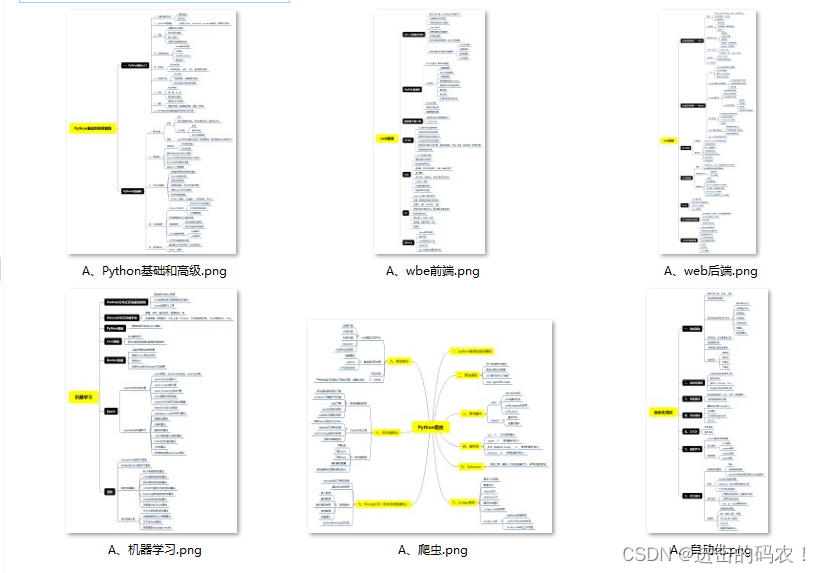
二、Python必备开发工具
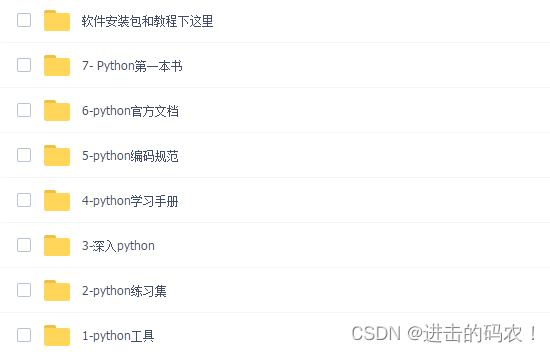
三、Python视频合集
观看零基础学习视频,看视频学习是最快捷也是最有效果的方式,跟着视频中老师的思路,从基础到深入,还是很容易入门的。
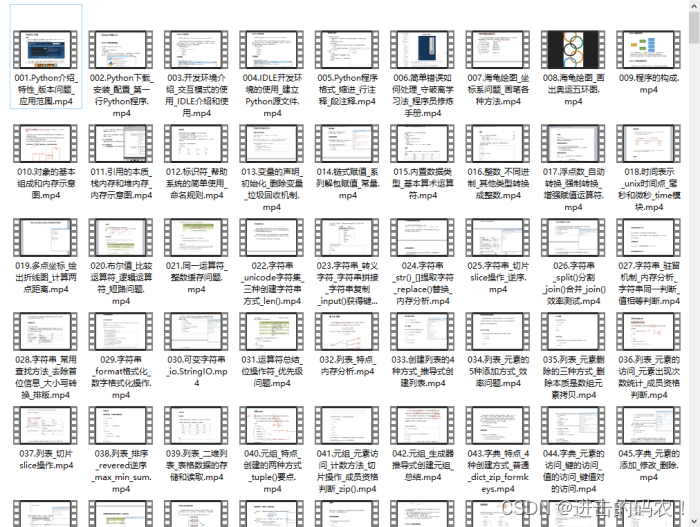
四、实战案例
光学理论是没用的,要学会跟着一起敲,要动手实操,才能将自己的所学运用到实际当中去,这时候可以搞点实战案例来学习。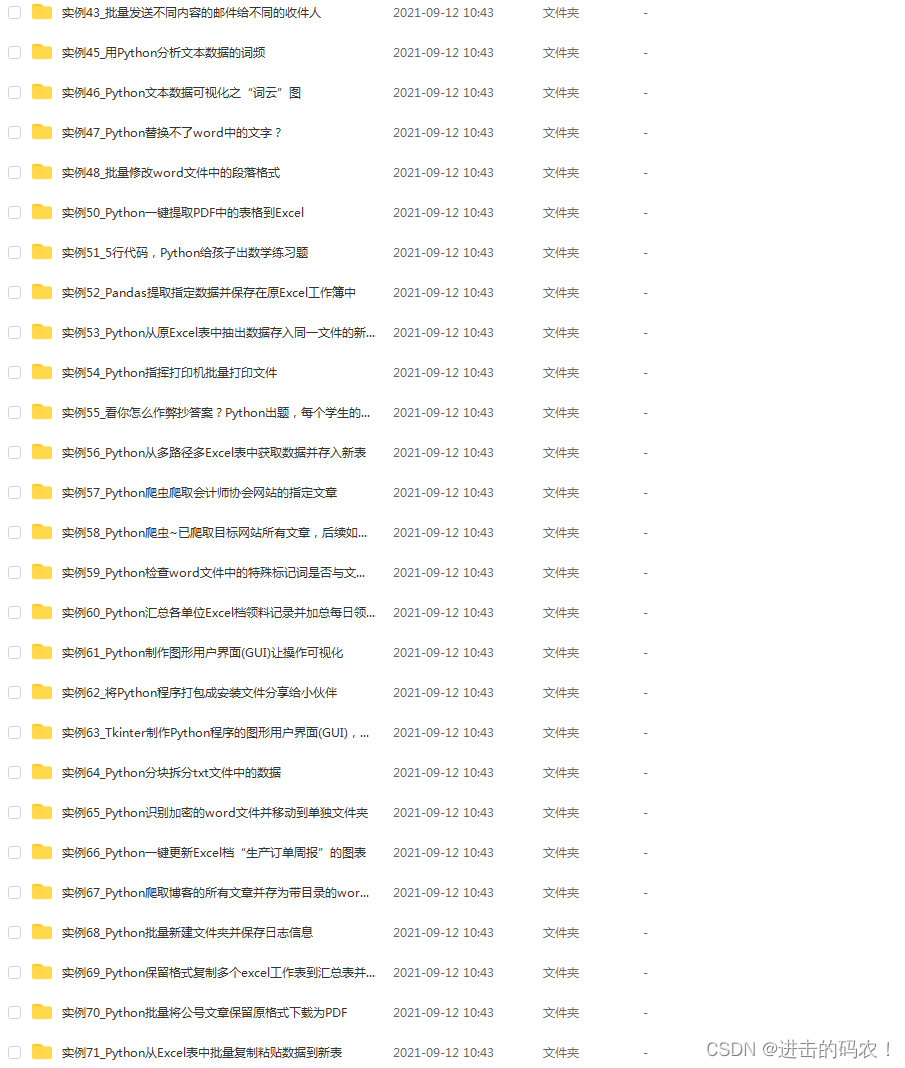
五、Python练习题
检查学习结果。
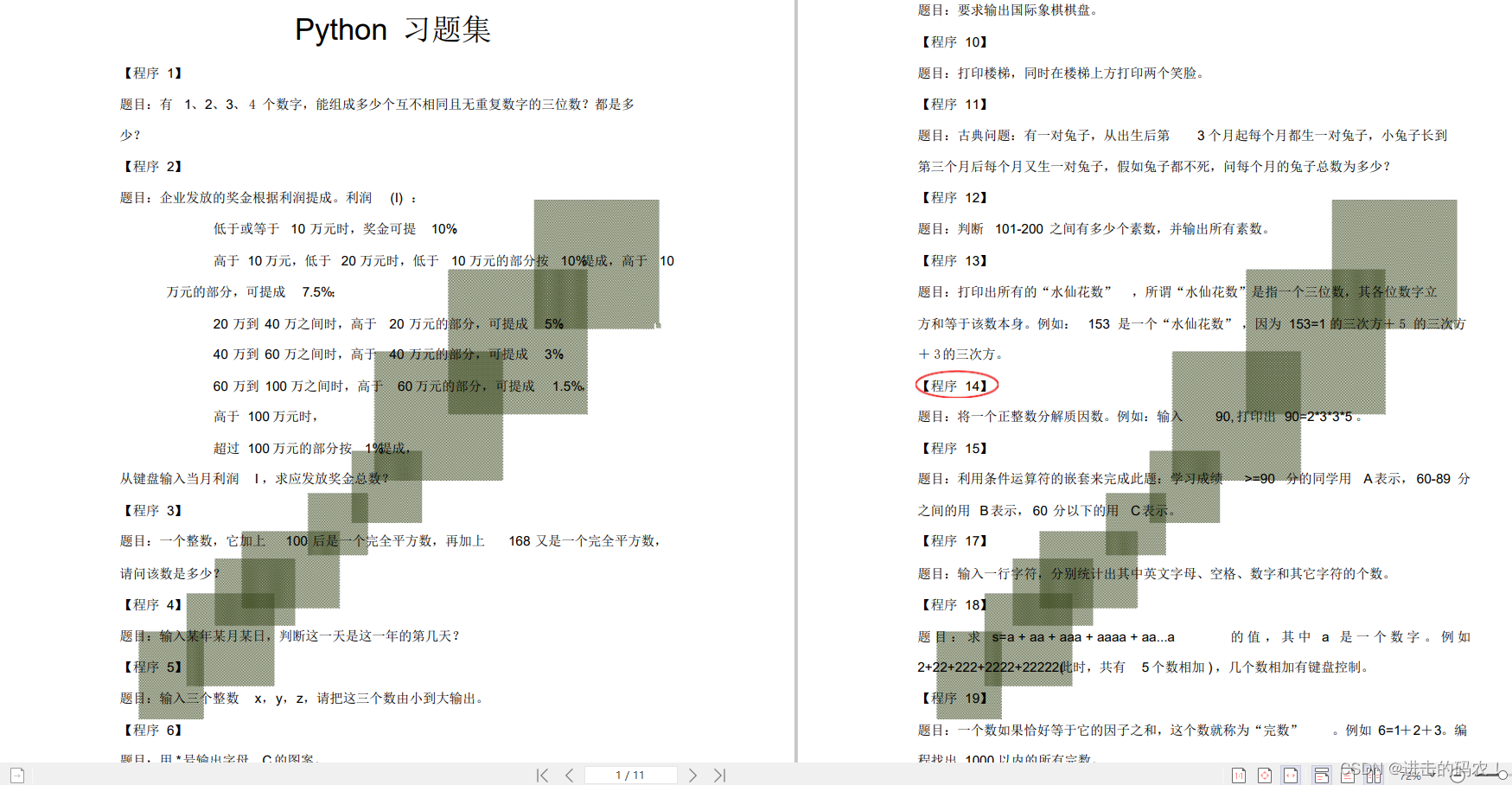
六、面试资料
我们学习Python必然是为了找到高薪的工作,下面这些面试题是来自阿里、腾讯、字节等一线互联网大厂最新的面试资料,并且有阿里大佬给出了权威的解答,刷完这一套面试资料相信大家都能找到满意的工作。
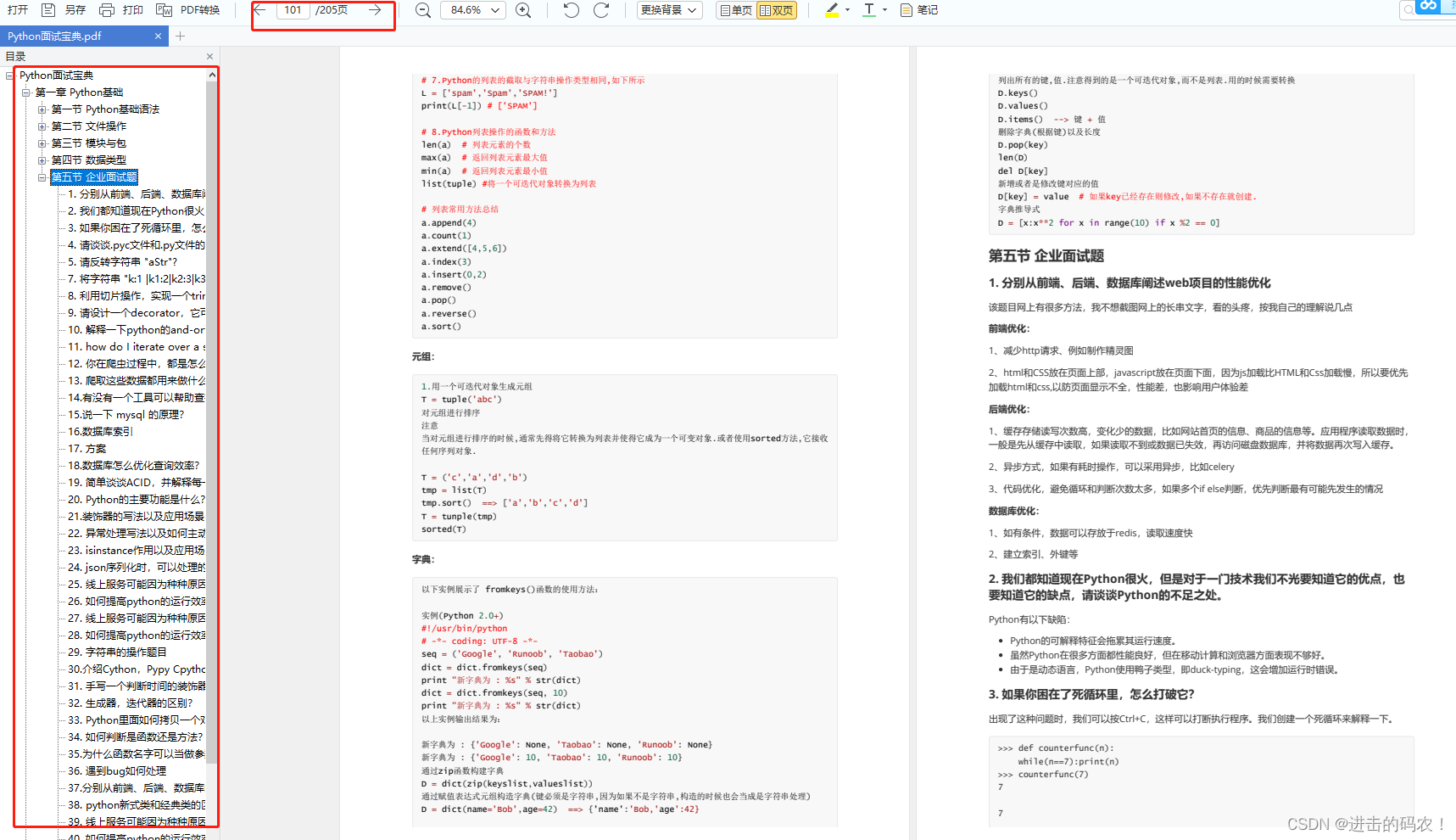
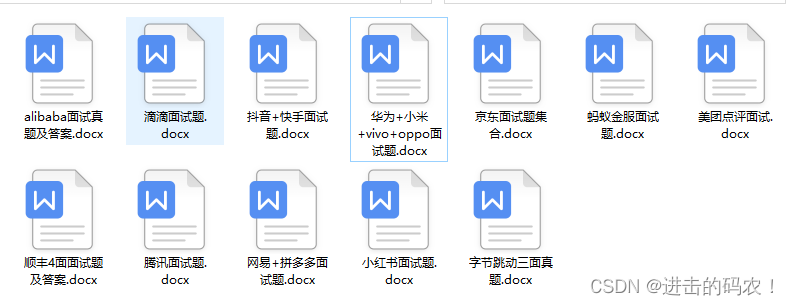
最后,千万别辜负自己当时开始的一腔热血,一起变强大变优秀。



